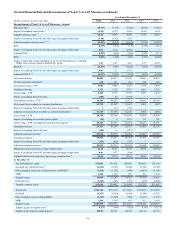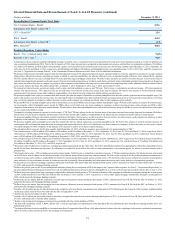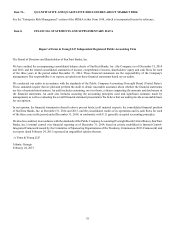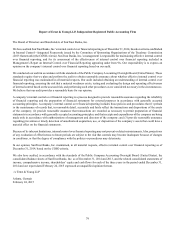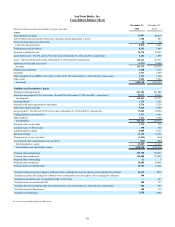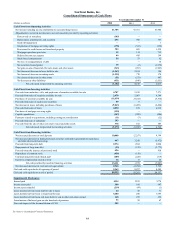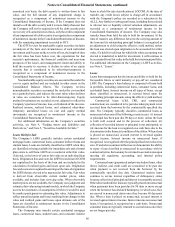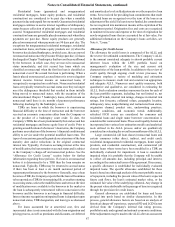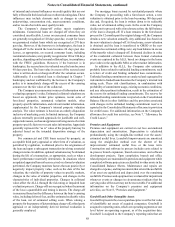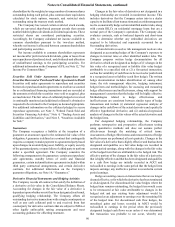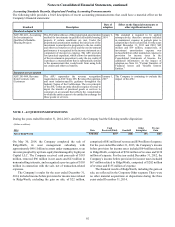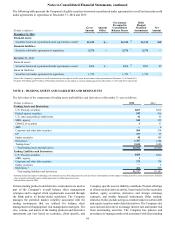SunTrust 2014 Annual Report Download - page 108
Download and view the complete annual report
Please find page 108 of the 2014 SunTrust annual report below. You can navigate through the pages in the report by either clicking on the pages listed below, or by using the keyword search tool below to find specific information within the annual report.Notes to Consolidated Financial Statements
85
NOTE 1 – SIGNIFICANT ACCOUNTING POLICIES
General
SunTrust, one of the nation's largest commercial banking
organizations, is a financial services holding company with its
headquarters in Atlanta, Georgia. Through its principal
subsidiary, SunTrust Bank, the Company offers a full line of
financial services for consumers and businesses, including
deposit, credit, mortgage banking, and trust and investment
services. Additional subsidiaries provide asset and wealth
management, securities brokerage and capital market services.
SunTrust operates primarily within Florida, Georgia, Maryland,
North Carolina, South Carolina, Tennessee, Virginia, and the
District of Columbia. In certain businesses, SunTrust also
operates in select markets nationally. SunTrust provides clients
with a selection of technology-based banking channels,
including the internet, mobile, ATMs, and telebanking.
SunTrust’s client base encompasses a broad range of individuals
and families, businesses, institutions, and governmental
agencies. SunTrust operated under the following business
segments during 2014: Consumer Banking and Private Wealth
Management, Wholesale Banking, and Mortgage Banking, with
functional activities included in Corporate Other. For additional
information on the Company’s business segments, see Note 20,
“Business Segment Reporting.”
Principles of Consolidation and Basis of Presentation
The consolidated financial statements include the accounts of
the Company and its subsidiaries after elimination of significant
intercompany accounts and transactions.
The Company holds VIs, which are contractual ownership
or other interests that change with changes in the fair value of a
VIE's net assets. The Company consolidates a VIE if it is the
primary beneficiary, which is the party that has both the power
to direct the activities that most significantly impact the financial
performance of the VIE and the obligation to absorb losses or
rights to receive benefits through its VIs that could potentially
be significant to the VIE. To determine whether or not a VI held
by the Company could potentially be significant to the VIE, both
qualitative and quantitative factors regarding the nature, size,
and form of the Company's involvement with the VIE are
considered. The assessment of whether or not the Company is
the primary beneficiary of a VIE is performed on an ongoing
basis. The Company consolidates VOEs, which are entities that
are not VIEs and are controlled through the Company's equity
interests or by other means.
Investments in companies which are not VIEs, or where the
Company is not the primary beneficiary of a VIE, that the
Company has the ability to exercise significant influence over
operating and financing decisions, are accounted for using the
equity method of accounting. These investments are included in
other assets in the Consolidated Balance Sheets at cost, adjusted
to reflect the Company's portion of income, loss, or dividends
of the investee. Equity investments that do not meet the criteria
to be accounted for under the equity method and that do not result
in consolidation of the investee are accounted for under the cost
method. Cost method investments are included in other assets in
the Consolidated Balance Sheets and dividends received or
receivable from these investments are included as a component
of other noninterest income in the Consolidated Statements of
Income.
Results of operations of acquired entities are included from
the date of acquisition. Results of operations associated with
entities or net assets sold are included through the date of
disposition. The Company reports any noncontrolling interests
in its subsidiaries in the equity section of the Consolidated
Balance Sheets and separately presents the income or loss
attributable to the noncontrolling interest of a consolidated
subsidiary in its Consolidated Statements of Income. Assets and
liabilities of an acquired entity are initially recorded at their
estimated fair values at the date of acquisition.
The preparation of financial statements in conformity with
U.S. GAAP requires management to make estimates and
assumptions that affect the reported amounts of assets and
liabilities, the disclosure of contingent assets and liabilities at
the date of the financial statements, and the reported amounts of
revenues and expenses during the reporting period. Actual results
could vary from these estimates. Certain reclassifications have
been made to prior period amounts to conform to the current
period presentation.
The Company evaluated subsequent events through the date
its financial statements were issued.
Cash and Cash Equivalents
Cash and cash equivalents include cash and due from banks,
interest-bearing deposits at other banks, Fed funds sold, and
securities borrowed and purchased under agreements to resell.
Cash and cash equivalents have maturities of three months or
less, and accordingly, the carrying amount of these instruments
is deemed to be a reasonable estimate of fair value.
Securities and Trading Activities
Debt securities and marketable equity securities are classified at
trade date as trading or securities AFS. Trading assets and
liabilities are carried at fair value with changes in fair value
recognized within noninterest income. Securities AFS are used
as part of the overall asset and liability management process to
optimize income and market performance over an entire interest
rate cycle. Interest income and dividends on securities are
recognized in interest income on an accrual basis. Premiums and
discounts on debt securities are amortized as an adjustment to
yield over the estimated life of the security. Securities AFS are
carried at fair value with unrealized gains and losses, net of any
tax effect, included in AOCI as a component of shareholders’
equity. Realized gains and losses, including OTTI, are
determined using the specific identification method and are
recognized as a component of noninterest income in the
Consolidated Statements of Income.
On a quarterly basis, securities AFS are reviewed for OTTI.
In determining whether OTTI exists for securities in an
unrealized loss position, the Company assesses whether it has
the intent to sell the security or, for debt securities, the Company
assesses the likelihood of selling the security prior to the recovery
of its amortized cost basis. If the Company intends to sell the
debt security or it is more-likely-than-not that the Company will
be required to sell the debt security prior to the recovery of its


